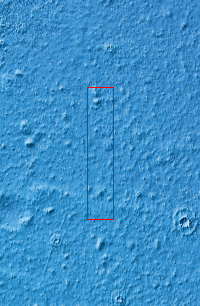
|
“Butterfly” Crater
- Click the image above for a larger view
- Full-Res JPEG (320 x 1808) (139.8 kB)
- Full-Res TIFF (320 x 1808) (579.4 kB)
Caption:
The ejecta pattern around this northern plains crater is termed "butterfly" for its similarity to butterfly wings. This type of ejecta pattern is common for oblique impacts. In this IR image the ejecta appears bright. This is because the rock ejecta is warmer than the surrounding dust covered plains.
Orbit Number: 54313 Latitude: 73.298 Longitude: 126.752 Instrument: IR Captured: 2014-03-12 23:41
Background Info:
Please see the THEMIS Data Citation Note for details on crediting THEMIS images.
NASA's Jet Propulsion Laboratory manages the 2001 Mars Odyssey mission for NASA's Science Mission Directorate, Washington, D.C. The Thermal Emission Imaging System (THEMIS) was developed by Arizona State University, Tempe, in collaboration with Raytheon Santa Barbara Remote Sensing. The THEMIS investigation is led by Dr. Philip Christensen at Arizona State University. Lockheed Martin Astronautics, Denver, is the prime contractor for the Odyssey project, and developed and built the orbiter. Mission operations are conducted jointly from Lockheed Martin and from JPL, a division of the California Institute of Technology in Pasadena.
Cataloging Keywords:
| Name | Value | Additional Values |
|---|---|---|
| Target | Mars | |
| System | ||
| Target Type | Planet | |
| Mission | 2001 Mars Odyssey | |
| Instrument Host | Mars Odyssey | |
| Host Type | Orbiter | |
| Instrument | Thermal Emission Imaging System (THEMIS) | |
| Detector | ||
| Extra Keywords | Crater, Dust, Grayscale, Impact, Infrared, Thermal | |
| Acquisition Date | ||
| Release Date | 2014-06-03 | |
| Date in Caption | 2014-03-12 | |
| Image Credit | NASA/JPL-Caltech/ASU | |
| Source | photojournal.jpl.nasa.gov/catalog/PIA18266 | |
| Identifier | PIA18266 | |

